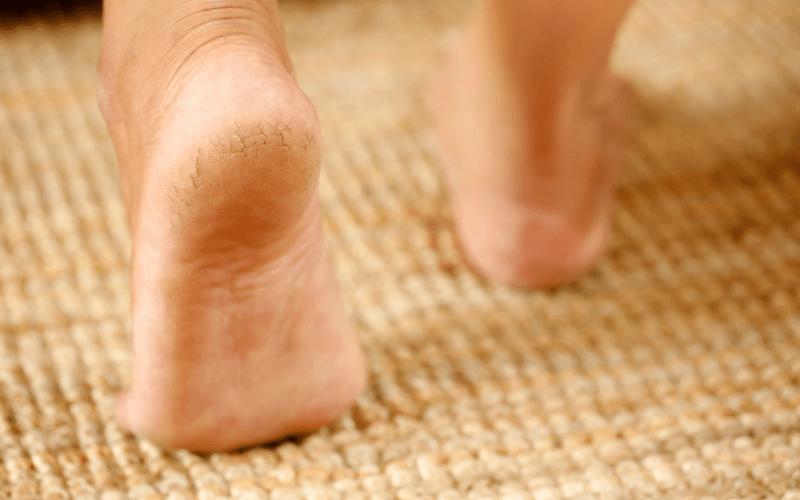Cracked heels are a common foot problem and a major cause of heel pain. The cracks (which are often referred to as heel fissures by chiropodists and podiatrists) are associated with dry skin. In some cases, however, they may also indicate that an individual is suffering from an underlying foot problem, as we’ll explain.
Dry Skin Cracks under Pressure
The skin on your feet is prone to dryness, as it has few natural oils. Cracks can appear if it’s extremely dry and inflexible instead of soft and supple. Standing, walking or running puts pressure on your heels and makes the fatty heel pads expand – and unhealthy skin may split as a result. Further pressure can widen and deepen the cracks and create new ones. In severe cases, cracked heels bleed and are agonising.
Cracks can also be a magnet for germs, because they stop skin acting as a protective barrier. If bacteria invade, you may develop cellulitis. This potentially serious infection affects skin’s deeper layers, making feet painful, hot and swollen, and requires urgent medical attention.
If the Cracks Are Stubborn, Athlete’s Foot Could Be to Blame
For many people, cracked heels are simply an indication that they’ve been forgetting to use a lotion and pumice stone, say, and the neglected skin is therefore no longer well moisturised, hydrated and smooth. Provided there’s no sign of a complication such as cellulitis, you may be able to treat the problem at home. If you regularly apply antiseptic to the cracks, massage a good-quality foot cream into your skin, file away dead skin, and drink plenty of water, your heels could recover in a matter of weeks.
But what if you prioritise foot care and don’t see a significant improvement or the fissures soon return? If cracked heels become a persistent issue, they may be a sign that you’re not just battling against dry skin. They can point to more serious foot conditions, ranging from hyperkeratosis to heel spurs. The most common of these conditions, and the one we’ll focus on here, is athlete’s foot. This fungal infection is so widespread that 70% of people will suffer from it at some stage, and treating it is a major part of our chiropody services.
The Infection Doesn’t Just Affect Toes
You’re probably surprised to hear that athlete’s foot could be the root cause of a stubborn case of cracked heels. After all, it’s primarily associated with the warm, moist area between the toes (which is so inviting to fungi), as well as the toenails (it can cause fungal nail issues such as brittleness and discolouration). Indeed, our extensive experience of providing London chiropody and podiatry services has shown us that many people aren’t even aware that athlete’s foot can actually have a detrimental effect on other parts of the feet too, including making heels dry and cracked.
If you’re struggling to overcome heel fissures, it’s worth considering whether you might have athlete’s foot and therefore need specialist treatment. To help focus your thoughts, we suggest asking yourself the following couple of questions.
- Does My Lifestyle Increase My Risk of Developing Athlete’s Foot Infections?
Athlete’s foot is highly contagious; you can catch it if you come into contact with infected skin or objects/surfaces contaminated with infected skin cells, especially if your feet are damp or have breaks in the skin at the time. For example, your risk of suffering from athlete’s foot is greater if an individual you live with has the infection, you share bath towels, hosiery or shoes with someone, or you go barefoot in communal areas such as gym changing rooms.
You’re also more likely to get athlete’s foot if (as the name suggests) you exercise a lot. The fungi thrive when exposed to hot, sweaty feet, especially if you don’t wear moisture-wicking socks and breathable trainers. The infection is also particularly common in the colder months when feet are encased in thick hosiery and boots.
- Do I Have Any Other Athlete’s Foot Symptoms?
It’s sensible to check your feet for any other signs of athlete’s foot in addition to cracked heels, including:
- Red, scaly rash
- Flaky, peeling skin
- White patches
- Sores and blisters
- Intense itching
- Burning/stinging sensation
- Inflammation
Expert Treatment at London Foot Clinics
If you suspect athlete’s foot has led to cracked heels, you can book an appointment at one of our London chiropody and podiatry clinics. In hygienic surroundings, we can provide a definitive diagnosis, plus draw up a treatment plan to eradicate the infection with topical/oral anti-fungal medication, heal cracks and remove dead skin.
For professional help to banish cracked heels, contact Feet By Pody today.

